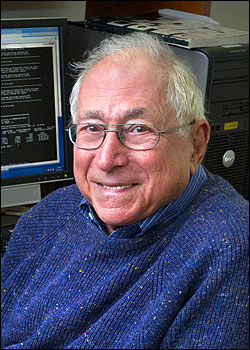James Cumming Named Senior Scientist Emeritus
December 28, 2011

James Cumming
James Cumming, who joined BNL’s Chemistry Department in 1954 and retired in 1998, has been named Senior Scientist Emeritus, an honorary designation for scientists who have made particularly noteworthy contributions to BNL’s reputation as a world-class scientific institution. Cumming is being recognized for his long and distinguished career at the Laboratory in which he used accelerators to explore and understand high-energy nuclear reactions. He also developed important innovations in methods and instrumentation to study such processes.
“During my 60-year association with BNL — from visits as a graduate student to use unique counting equipment in the Chemistry Department to my work here in ‘retirement’ — I have seen enormous changes in the scale of science,” Cumming said. “Compare, for example, the Cosmotron to the Relativistic Heavy Ion Collider. High-speed computers have replaced the slide rule, and graph paper has become an antique. New instrumentation and radiation detection devices have made difficult measurements routine.”
“I do have some nostalgia for the older times of more intimate connection among an experiment, the data, and the scientist, but it has always been fun to work at the Lab. I’ve been able to work in a broad range of areas, and I am grateful for this recognition.”
Probing Nuclear Reactions
When Cumming arrived at BNL in early 1954, he joined a group of chemists who, led by Gerhardt Friedlander, were surveying nuclear reaction cross sections at the recently commissioned Cosmotron. A cross section is a measure of the probability that an encounter between a projectile and a target will result in a particular reaction product – crucial information for evaluating reaction mechanisms and of considerable practical value for determining beam intensities and profiles for other accelerator experiments.
When a high-energy projectile interacts with a heavy element, the excited target may break up into multiple small fragments. This “multifragmentation” process was first observed at BNL. Cumming realized that detailed measurements of the energy and angular distributions of these fragments would better identify reaction mechanisms. From these first basic measurements at the Cosmotron to studies of heavy-ion interactions at the Alternating Gradient Synchrotron (AGS), this would be a major thread in Cumming’s research.
In the 1980s, Cumming joined online heavy-ion experiments at the AGS. He led the downstream calorimeter group and developed the hardware and software to optimize the performance of ZCAL, the Zero-degree CALorimeter. This detector measures the energy remaining in projectile-like fragments that emerge from an interaction. The ZCAL energy enables subsequent analysis of events on the basis of impact parameter. For example, a low residual energy indicates a violent central collision, and a high energy, a peripheral one.
Going Digital
Cumming also was noted for applying digital computation for the analysis of experimental data. Generations of nuclear chemists had used graphical procedures to resolve complex radioactive decay curves. These were time-consuming and not always reliable. In work starting at New York University’s large-scale digital computer, UNIVAC, and continued at BNL, Cumming developed a computer program, dubbed CLSQ, which became a standard tool for nuclear chemists worldwide. It is used in multiple areas, from studies in art and archeology using neutron activation techniques, to assessing drug uptake and clearance, and even in oil-well logging.
A New Facility
In another research area, Cumming, along with BNL’s Seymour Katcoff, developed BNL’s Chemistry Linac Irradiation Facility (CLIF) to exploit the high current capabilities of the new linac injector to the AGS, which began operations in 1960. Proton and neutron beams in CLIF were used to produce a wide range of new radioisotopes that were studied and characterized. While CLIF has been decommissioned, the Brookhaven Linac Isotope Producer has taken its place, providing commercially unavailable radioisotopes to the nuclear medicine community, industry, and researchers.
An Active Retirement
In his ‘retirement,’ Cumming works three days a week. Recently, he has collaborated with the Solar Neutrino Group in developing new scintillators for large neutrino detectors such as those that are currently being used at the Daya Bay project in China and in other experiments. He has been a major contributor to several papers from this group and continues to provide data analysis and modeling software.
Over the past several years, Cumming has provided valuable service to the Chemistry Department by cataloguing, consolidating, and, in some cases, preparing legacy radioactive materials for disposal. These materials remained in the Chemistry Department from the days when nuclear research was a major effort. Many of these were poorly characterized, posing problems for disposal. Based on his extensive “process knowledge,” and using an in-house gamma-ray detector, Cumming, working with Joe Vignola, Radiological Control Division, systematically worked through this legacy material. Much of it was prepared for disposal, while some samples were characterized and retained for future use. A complete inventory of the retained samples was prepared.
Cumming earned a B.S. in chemistry from Yale University in 1949, and an A.M. and Ph.D. in chemistry from Columbia University in 1950 and 1954, respectively. He joined BNL as a research associate in 1954, and worked his way through the ranks to become a senior chemist with tenure in 1969. He has been retired since June 1998.
2011-2780 | INT/EXT | Newsroom









